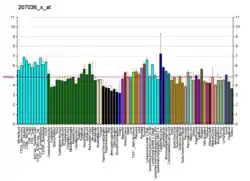GRIN2D
Glutamate [NMDA] receptor subunit epsilon-4 is a protein that in humans is encoded by the GRIN2D gene.[5][6][7]
Function
N-methyl-D-aspartate (NMDA) receptors are a class of ionotropic glutamate receptors. NMDA channel has been shown to be involved in long-term potentiation, an activity-dependent increase in the efficiency of synaptic transmission thought to underlie certain kinds of memory and learning. NMDA receptor channels are heteromers composed of the key receptor subunit NMDAR1 (GRIN1) and 1 or more of the 4 NMDAR2 subunits: NMDAR2A (GRIN2A), NMDAR2B (GRIN2B), NMDAR2C (GRIN2C), and NMDAR2D (GRIN2D).[7]
Interactions
GRIN2D has been shown to interact with Interleukin 16.[8]
See also
References
- GRCh38: Ensembl release 89: ENSG00000105464 - Ensembl, May 2017
- GRCm38: Ensembl release 89: ENSMUSG00000002771 - Ensembl, May 2017
- "Human PubMed Reference:". National Center for Biotechnology Information, U.S. National Library of Medicine.
- "Mouse PubMed Reference:". National Center for Biotechnology Information, U.S. National Library of Medicine.
- Kalsi G, Whiting P, Bourdelles BL, Callen D, Barnard EA, Gurling H (Apr 1998). "Localization of the human NMDAR2D receptor subunit gene (GRIN2D) to 19q13.1-qter, the NMDAR2A subunit gene to 16p13.2 (GRIN2A), and the NMDAR2C subunit gene (GRIN2C) to 17q24-q25 using somatic cell hybrid and radiation hybrid mapping panels". Genomics. 47 (3): 423–5. doi:10.1006/geno.1997.5132. PMID 9480759.
- Watanabe T, Inoue S, Hiroi H, Orimo A, Kawashima H, Muramatsu M (Jan 1998). "Isolation of estrogen-responsive genes with a CpG island library". Mol. Cell. Biol. 18 (1): 442–9. doi:10.1128/mcb.18.1.442. PMC 121513. PMID 9418891.
- "Entrez Gene: GRIN2D glutamate receptor, ionotropic, N-methyl D-aspartate 2D".
- Kurschner C, Yuzaki M (Sep 1999). "Neuronal interleukin-16 (NIL-16): a dual function PDZ domain protein". J. Neurosci. 19 (18): 7770–80. doi:10.1523/JNEUROSCI.19-18-07770.1999. PMID 10479680.
Further reading
- Schröder HC, Perovic S, Kavsan V, Ushijima H, Müller WE (1998). "Mechanisms of prionSc- and HIV-1 gp120 induced neuronal cell death". Neurotoxicology. 19 (4–5): 683–8. PMID 9745929.
- King JE, Eugenin EA, Buckner CM, Berman JW (2006). "HIV tat and neurotoxicity". Microbes Infect. 8 (5): 1347–57. doi:10.1016/j.micinf.2005.11.014. PMID 16697675.
- Kornau HC, Schenker LT, Kennedy MB, Seeburg PH (1995). "Domain interaction between NMDA receptor subunits and the postsynaptic density protein PSD-95". Science. 269 (5231): 1737–40. doi:10.1126/science.7569905. PMID 7569905.
- Magnuson DS, Knudsen BE, Geiger JD, Brownstone RM, Nath A (1995). "Human immunodeficiency virus type 1 tat activates non-N-methyl-D-aspartate excitatory amino acid receptors and causes neurotoxicity". Ann. Neurol. 37 (3): 373–80. doi:10.1002/ana.410370314. PMID 7695237. S2CID 24405132.
- Lannuzel A, Lledo PM, Lamghitnia HO, Vincent JD, Tardieu M (1995). "HIV-1 envelope proteins gp120 and gp160 potentiate NMDA-induced [Ca2+]i increase, alter [Ca2+]i homeostasis and induce neurotoxicity in human embryonic neurons". Eur. J. Neurosci. 7 (11): 2285–93. doi:10.1111/j.1460-9568.1995.tb00649.x. PMID 8563977. S2CID 27201873.
- Corasaniti MT, Melino G, Navarra M, Garaci E, Finazzi-Agrò A, Nisticò G (1995). "Death of cultured human neuroblastoma cells induced by HIV-1 gp120 is prevented by NMDA receptor antagonists and inhibitors of nitric oxide and cyclooxygenase". Neurodegeneration. 4 (3): 315–21. doi:10.1016/1055-8330(95)90021-7. PMID 8581564.
- Akbarian S, Sucher NJ, Bradley D, Tafazzoli A, Trinh D, Hetrick WP, Potkin SG, Sandman CA, Bunney WE, Jones EG (1996). "Selective alterations in gene expression for NMDA receptor subunits in prefrontal cortex of schizophrenics". J. Neurosci. 16 (1): 19–30. doi:10.1523/JNEUROSCI.16-01-00019.1996. PMC 6578738. PMID 8613785.
- Pittaluga A, Pattarini R, Severi P, Raiteri M (1996). "Human brain N-methyl-D-aspartate receptors regulating noradrenaline release are positively modulated by HIV-1 coat protein gp120". AIDS. 10 (5): 463–8. doi:10.1097/00002030-199605000-00003. PMID 8724036. S2CID 1669986.
- Wu P, Price P, Du B, Hatch WC, Terwilliger EF (1996). "Direct cytotoxicity of HIV-1 envelope protein gp120 on human NT neurons". NeuroReport. 7 (5): 1045–9. doi:10.1097/00001756-199604100-00018. PMID 8804048. S2CID 21018147.
- Bennett BA, Rusyniak DE, Hollingsworth CK (1995). "HIV-1 gp120-induced neurotoxicity to midbrain dopamine cultures". Brain Res. 705 (1–2): 168–76. doi:10.1016/0006-8993(95)01166-8. PMID 8821747. S2CID 32822686.
- Toggas SM, Masliah E, Mucke L (1996). "Prevention of HIV-1 gp120-induced neuronal damage in the central nervous system of transgenic mice by the NMDA receptor antagonist memantine". Brain Res. 706 (2): 303–7. doi:10.1016/0006-8993(95)01197-8. PMID 8822372. S2CID 44260060.
- Dreyer EB, Lipton SA (1995). "The coat protein gp120 of HIV-1 inhibits astrocyte uptake of excitatory amino acids via macrophage arachidonic acid". Eur. J. Neurosci. 7 (12): 2502–7. doi:10.1111/j.1460-9568.1995.tb01048.x. PMID 8845955. S2CID 7370984.
- Raber J, Toggas SM, Lee S, Bloom FE, Epstein CJ, Mucke L (1996). "Central nervous system expression of HIV-1 Gp120 activates the hypothalamic-pituitary-adrenal axis: evidence for involvement of NMDA receptors and nitric oxide synthase". Virology. 226 (2): 362–73. doi:10.1006/viro.1996.0664. PMID 8955056.
- Scherzer CR, Landwehrmeyer GB, Kerner JA, Standaert DG, Hollingsworth ZR, Daggett LP, Veliçelebi G, Penney JB, Young AB (1997). "Cellular distribution of NMDA glutamate receptor subunit mRNAs in the human cerebellum". Neurobiol. Dis. 4 (1): 35–46. doi:10.1006/nbdi.1997.0136. PMID 9258910. S2CID 20991142.
- Hess SD, Daggett LP, Deal C, Lu CC, Johnson EC, Veliçelebi G (1998). "Functional characterization of human N-methyl-D-aspartate subtype 1A/2D receptors". J. Neurochem. 70 (3): 1269–79. doi:10.1046/j.1471-4159.1998.70031269.x. PMID 9489750. S2CID 22433867.
- Kurschner C, Mermelstein PG, Holden WT, Surmeier DJ (1998). "CIPP, a novel multivalent PDZ domain protein, selectively interacts with Kir4.0 family members, NMDA receptor subunits, neurexins, and neuroligins". Mol. Cell. Neurosci. 11 (3): 161–72. doi:10.1006/mcne.1998.0679. PMID 9647694. S2CID 36534759.
- New DR, Maggirwar SB, Epstein LG, Dewhurst S, Gelbard HA (1998). "HIV-1 Tat induces neuronal death via tumor necrosis factor-alpha and activation of non-N-methyl-D-aspartate receptors by a NFkappaB-independent mechanism". J. Biol. Chem. 273 (28): 17852–8. doi:10.1074/jbc.273.28.17852. PMID 9651389.
External links
- GRIN2D+protein,+human at the US National Library of Medicine Medical Subject Headings (MeSH)
This article incorporates text from the United States National Library of Medicine, which is in the public domain.





